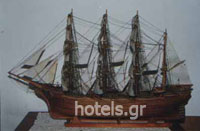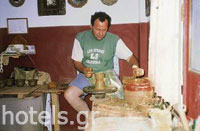|
Traditional Activities and Folk Handicrafts
There are many islanders that have continued their traditional family trades and crafts, not only as a means of income, but to ensure the trade is not lost. Most of the current traditional craftsmen were apprentices who learned their trade under the watchful eye of an old craftsman, many of which were their fathers and grandfathers. Despite the difficulties that these the old professions encountered, the naval carpenters had no work when the shipyards closed and the old ceramic workshops were industrialised. There are, fortunately, islanders that have continued with their traditional professions: timber carving, painting, stonemasons, iron workers, potters, tanners, wool making, embroidery, weavers, to name a few.
Five traditional craftsmen - artisans of Skopelos are presented below.
 Triandafyllos Boundalas
Triandafyllos Boundalas
His profession is shipbuilder, constructor of various types of boats. His yard is located in a regional street of Skopelos, admire his work, or even buy one of his splendid boats. Triantafyllos Boundalas was born in the Skopelos 1927.
He comes from a family of naval carpenters and shipbuilders their art has been handed down from generation to generation. His great-grandfather was a master craftsman in the Kostantza in the Black Sea that was also his homeland; he had two shipyards there in Kostantza and in Vraila and made many boats. His grandfather was also a good shipbuilder. His father went to America where he made his own shipyard and later returned to Skopelos and continued working in shipyards, taking with him and his son Triantafyllos, who started learning the trade at the early age of 15 years.
He learned and loved the craft even though his family had intended him for priesthood. When the shipyards began to close in Skopelos, and wooden ships were succeeded by metal that were cheaper and easier to build Triantafyllos turned his attention to model boats. All the model boats are precision made copies of real boats and are able to float on the sea. The creation and manufacture of a faithful model boat takes 8 months or more. This traditional art is continued by his son Yannis Boundalas and his wife Ourania.
Triantafyllos Boundalas and his children can be visited at their workshop on the Main regional road of Skopelos. Admire their work or even order one of their splendid model boats that start from 1.20 m to 3.70m. Workshop Telephone: 24240 23755 & 24240 24323.
 Nikos Rodios
Nikos Rodios
Nikos Rodios is a third generation potter of Cycladic origin, his family has written history in the art of pottery. His grandfather, Nikolaos Rodios or Paparodios who came from Kythnos and moved to Skopelos in 1900, was an experienced artist, inspired by the masterpieces of ancient vessels and learned his art in the Levanti Workshop in Botanico in the Athens area. He was so good that the older experience potters named the 14 year old, a Master Potter. From 1907 he began to exhibit his work and his talent gained many Greek and international awards. His work was so good that it was difficult to distinguish it from the ancient works of art that were in demand in Greece as well as abroad for their lustre, brilliance and black colour.
He applied for a patent in 1930. Eleftherios Venizelos wrote to him in 1931 praising his work. As with his grandson, Nikolas Rodios, has worked in many ceramic centres apart from Greece, Turkey, Romania and Egypt, but this did not influence his own technique that was based clearly on the classic archaeological art.
The Eleftheroudaki Encyclopaedia has him listed as the first Greek virtuoso of the wheel and as the father of pottery, the Athens Academy honoured him with a State Pension. Many politicians, Rallis, Baltatzis, Kalimasiotis, visited his workshop and purchased pieces during that period as Skopelos was a place of exile.
The art his grandfather Nikolaos taught to his sons Giorgos and Vasilis Rodio. Vasilis followed the art in the style of his father and participated in many international exhibitions gaining distinctions and awards. His brother, Giorgios the Rodios, had started working at the age of 14 beside his father, passed on the knowledge of the art to his son Nikos Rodios. Nikos is an artist and uses the same traditional production methods; apart from the old archaic shaped pieces he has established other forms. The Nikos Rodios workshop and shop exhibiting examples of his work is located in Hora, Skopelos. Telephone: 24240 22779
Christos Patsis
"The technique of the manufacture of knives in Skopelos is passed from generation to generation and the cutler wrote his name above the name of his island" said the Christos Patsis.
The oldest heard of was Giorgos Koustrelos, there were Giakimis, Lemonis who worked at the same time and was the third generation knife maker, Asteriadis who stole the technique by secretly watching the master cutlers at work. In those days the cutlers did not show their art to outsiders.
Now he is the last one that manufactures these handmade knives. He loves this work and wants to teach it to his son so that the profession is not lost from the island. The blade becomes wrought in the anvil and it is from stainless steel while the handle is made from goat horns that have been left to dry for 3 years. The horns are heated in the fire and shaped then placed in a vice and left to dry. The handmade knives of Uncle Christos are rare and coveted. He makes about 300 pieces during the winter to sell during the summer.
His workshop is in Hora, Skopelos. Telephone: 24240 23440.
Giorgios Lithadiotis
Georgios Lithadiotis is the third generation lantern maker. His grandfather made lanterns when they were in much demand, prior to the advent of electricity. These lanterns were placed outside each house, churches and monasteries, some still retain their lanterns. He made lanterns for prospective bridegrooms as tradition demanded that they presented the future bride with a lantern upon acceptance of his proposal.
The Kanari Lithadioti lanterns were tasteful and well worked with various decorations using a separate technique. The support columns and the glass panes were rounded as opposed to those of others that were square shaped and using copper or lead. "The materials" - says Giorgos - "were made by themselves. They worked with a brazier and charcoal and made them out of tin, the glass from opalina using a variety of ways and techniques to colour the glass".
Giorgos learned the art from his father, Vasilis the Lithadioti, a person that learned it from his own father and loved the art of lantern maker and had his own son Giorgos from an early age with him. He made lanterns with daisies made from the same material. Lanterns that were placed above the horses and on the carriages and carts were all over Hora, Glossa and Skiathos. Giorgos makes the traditional lantern and marine lanterns for the boats. He has the craft in his soul, from his father and from his grandfather.
From 1978 he has had his own shop and in his workshop works galvanized sheet-metal, pewter, copper and zinc. "I can work" - says Giorgos - "stainless steel and delicate items like chandeliers by hand of course, I forge, because stainless is the hardest metal." As a material he works with copper and brass because they are softer materials and more durable. He still makes silver jewellery. His lanterns are beautiful and you can him find in the Lantern shop run by his wife Ourania and located in Hora, Skopelos. Shop telephone: 24240 22530 - Workshop Telephone: 24240 23091 - located in Sofadakia.
Elias Prokopiou
Elias Prokopiou is a painter and was born and lives permanently on Skopelos. He is the eighth of the nine children of a large family and worked from small child to help support his family. From an early age, whilst still at school, Elias worked during the summertime harvesting greengages and later at the age of 13 years he worked at a brick making kiln belonging to Thanasis Kathinioti. Later, when the factory closed, he went to Athens, where he worked in various jobs and finally in the heavy work of a building site. In the interval that remained and worked in Athens and from 1975 was active in his union and was politicized. Through this politicization and hard work his interest in culture and art was aroused.
He began to read, to follow the course and works of the engravers Tassou, Semertzidi, Vallia and others, his sensitivities were awakened. His talent appeared by accident when he found a box of children’s watercolours and two small paintbrushes he began to copy a seascape. He succeeded in the end there began his passion for painting. He is not satisfied with just copies and successfully creates his own work. His artistic talents were also applied to sculpture in stone and timber. The result of which is the creation of beautiful pieces that combine painting and sculpture. He lives in Hora, Skopelos. Telephone: 24240 24228
|


